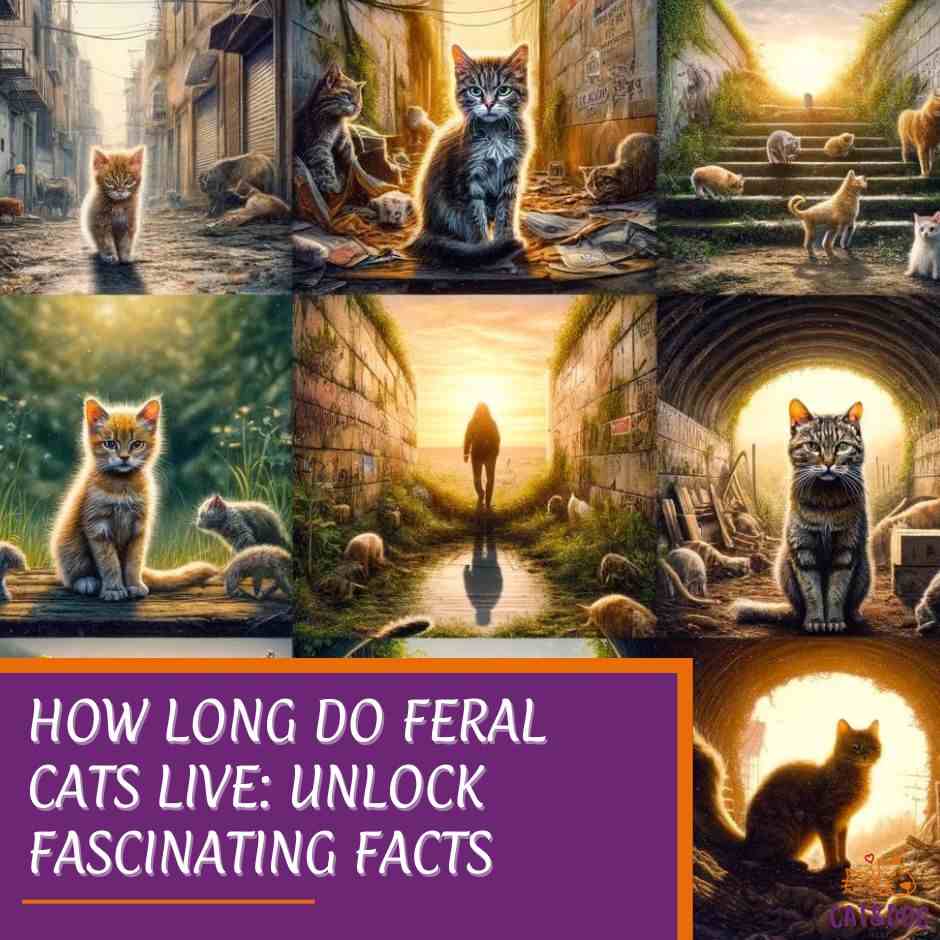How long do Feral Cats live?
Feral cats, distinguishable from the friendly stray meowing at your door, are the wild cousins of our domesticated feline friends.
The average lifespan of wild cats ranges from 2-5 years compared to domestic cats, which can live for 12-15 years
These are unowned, unsocialized cats that prefer the freedom of living outdoors without direct human contact, similar to other wild animals like squirrels, raccoons, and opossums.
They’re a familiar sight across neighborhoods and alleyways, hinting at a global population that’s more than just a nuisance away from small.
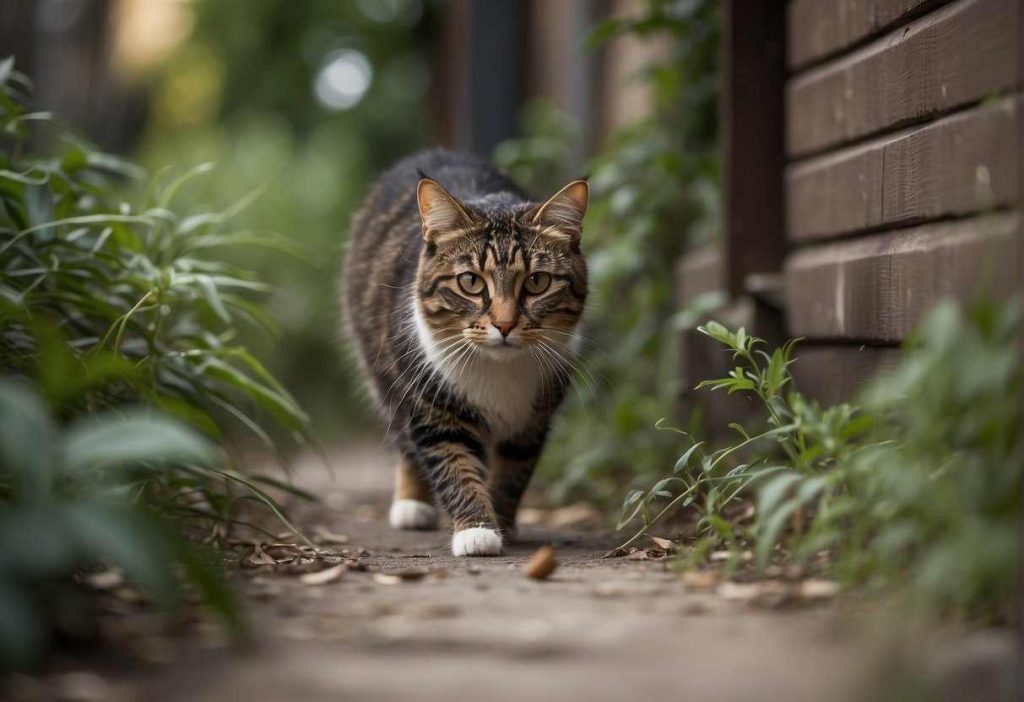
Getting to grips with the lives of feral cats isn’t a walk in the park. Their lives weave through the complexities of survival, navigating threats that range from disease to human interference.
Yet, amidst the dumpster-diving and territory-patrolling, feral cats demonstrate resilience and adaptability.
Interactions with human environments present both hazards and opportunities for these fiercely independent animals.
Over time, many feral-behaving cats relax enough to rub their human legs and be touched; some cats eventually become adoptable and live as housecats.
So, can these adventurous cats live out their nine lives under the stars for much longer?
With long-term attempts at socialization, some feral cats may become more comfortable with their caretakers, but they usually remain aloof and are most active after dusk.
However, with regular feeding and care, some stray cats can learn to recognize their caretakers and even become housecats.
Key Takeaways
- Feral cats, which are distinct from stray and community cats, face a variety of survival challenges outdoors.
- These cats are a significant presence globally, indicating their successful adaptation to diverse environments.
- Understanding and supporting the well-being of feral cats can lead to extended lifespans beyond the average expectancy.
How Long Do Feral Cats Live?
While your pampered pet cat has the potential to celebrate its 15th birthday or beyond, feral cats lead much tougher lives.
Research indicates that a feral cat’s average lifespan ranges from 2-5 years compared to the 12-15 years a domestic cat might enjoy. Why such a big gap? (1)
Well, feral cats face a host of challenges, including reaching sexual maturity at six months of age and having multiple litters each year.
This constant breeding and the harsh realities of living in the wild contribute to their shorter lifespan, with their first year of life being equivalent to roughly 15 human years.
However, it is important to note that the lifespan of feral cats can vary depending on their breed, with some breeds such as Bengal, Abyssinian, Sphynx, Maine Coons, and Devon Rex having shorter lifespans than others.
Interestingly, crossbred feral cats have been found to have longer median lifespans than purebred cats, possibly due to a reduced risk of inheriting breed-specific diseases.
Therefore, understanding the impact of breeds on the lifespan of feral cats is crucial for their survival in the wild.
Additionally, providing proper care and shelter for outdoor cats can greatly increase their chances of living a longer, healthier life.
- Exposure to harsh weather (2)
- Scarcity of food
- Lack of proper veterinary care
- Potential for disease and injury (3)
But what changes the game for these outdoor adventurers?
Access to consistent food sources and shelter can be a game-changer.
When these cats are supported by community feeding programs and provided with makeshift shelters, their lives aren’t just easier, they can live longer.
Take some feral cat colonies, for instance, where care from local cat lovers has led to a furrier and happier lives, sometimes extending to 7-10 years.
Health care, or the lack thereof, is a serious factor too. It’s not uncommon for diseases such as Feline Immunodeficiency Virus (FIV) and Feline Leukemia Virus (FeLV) to cut their lives short.
Even a simple upper respiratory infection can be life-threatening without medical attention.
But there’s hope!
Trap-Neuter-Return (TNR) programs that include vaccination efforts have been shown to combat the spread of disease effectively. (4)
Lastly, let’s chat about your role! Have you heard about TNR? It’s not just a movement; it’s a lifeline.
By participating in or supporting TNR programs, you’re not only helping to manage the feral population but also boosting the health and longevity of each cat.
Addressing The Knowledge Gap About Feral Cats
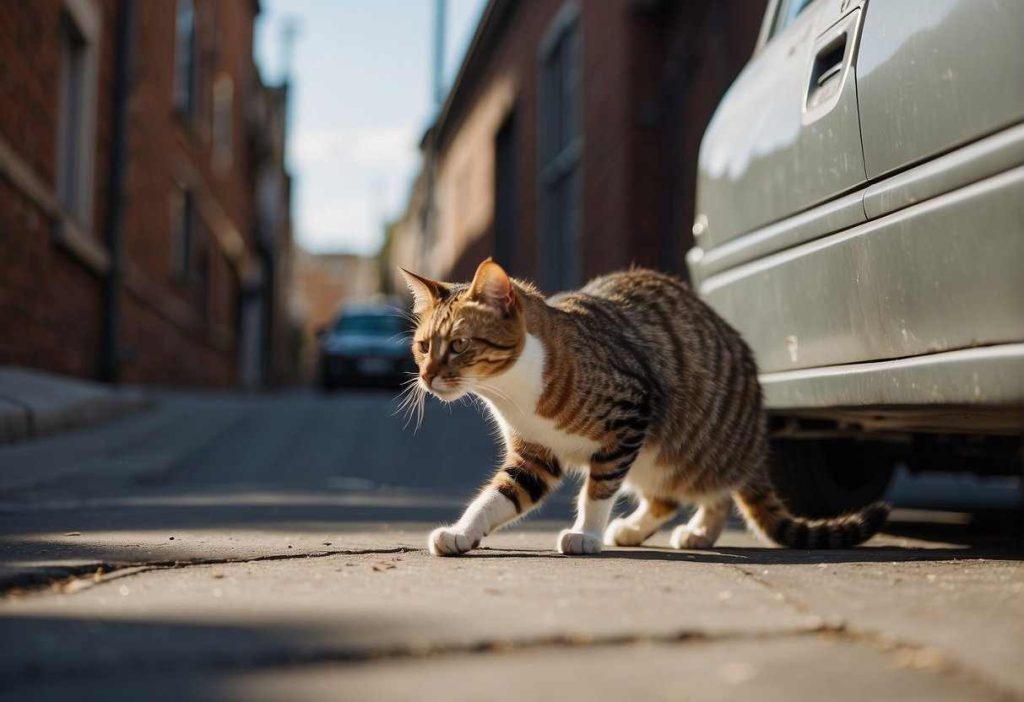
Finding accurate data on these elusive felines can be tougher than a cat’s tongue on your hand!
The Missing Lifespan Data
Let’s pounce on the facts. Got a minute to talk numbers? While your pet cat might nap on your keyboard for what feels like a lifetime, feral cats often have shorter lives.
Digging through the internet jungle, you’ll find estimates between 2-5 years on average. But guess what?
With the TLC of Trap-Neuter-Return (TNR) programs, these wild whiskered wanderers can possibly hit the 7-10-year mark.
Enhancing Content with Lifespan Information
Here’s the scoop – lifespan stats aren’t just numbers. They show a feral cat’s tale of survival. But hold on, wouldn’t you prefer these figures be as common as cat memes? Me too.
Sprinkling specific lifespan data across info platforms can make the feral feline world clearer for cat fans like you.
- TNR stats: TNR can extend lives.
- Feral vs. Stray: They’re different, and so are their life expectancies.
Linking TNR Outcomes to Lifespan
You might wonder, does TNR matter? You bet your favorite cat toy it does! These programs don’t just reduce kitty populations; they’re like a power-up for feral cat health.
Sterilized and vaccinated, these cats can dodge some of those mean street hazards.
| Typical Lifespan | With TNR Care | |
| Feral Cats | 2-5 years | 7-10 years or longer |
Isn’t it interesting how a little human intervention can write a new chapter in a feral cat’s life? So, let’s be the best narrators we can be for these feline friends. What say you?
Enhancing the Lives of Feral Cats

The goals are simple: reduce breeding, cut down on noisy mating rituals, and lessen the risk of injuries from territorial squabbles. (5)
By implementing spay and neuter practices, we can enhance the lives of feral cats and improve their overall well-being in the wild.
Did you know? Implemented correctly, TNR can lead to fewer fights over mates and territory.
Community Involvement and Support: Love cats and want to lend a paw? It’s not only about food; it’s about smart, safe support.
- Safe Feeding Practices: Use feeding stations to keep food dry and tidy.
- Maintain a routine to prevent overpopulation at feeding sites.
- Shelter Construction: Ever tried DIY? Building a cat shelter is a weekend project that saves lives! Find tutorials online to create a warm, secure spot for feral cats to snooze.
- Keep it simple with straw for insulation—never blankets or towels, which retain moisture.
So, where’s the proof this community love makes a difference? Take the story of one bustling city colony:
With locals pitching in, these urban prowlers enjoyed shelter, regular meals, and TNR benefits, extending their lives beyond that 2-5 year average to a heartwarming 7-10 years! 🏙️🐈
By chipping in, you become part of a community effort that doesn’t just feed but truly nurtures feral cats. They might not say thank you, but their purrs are worth a thousand words!
Challenges and Threats to Feral Cats
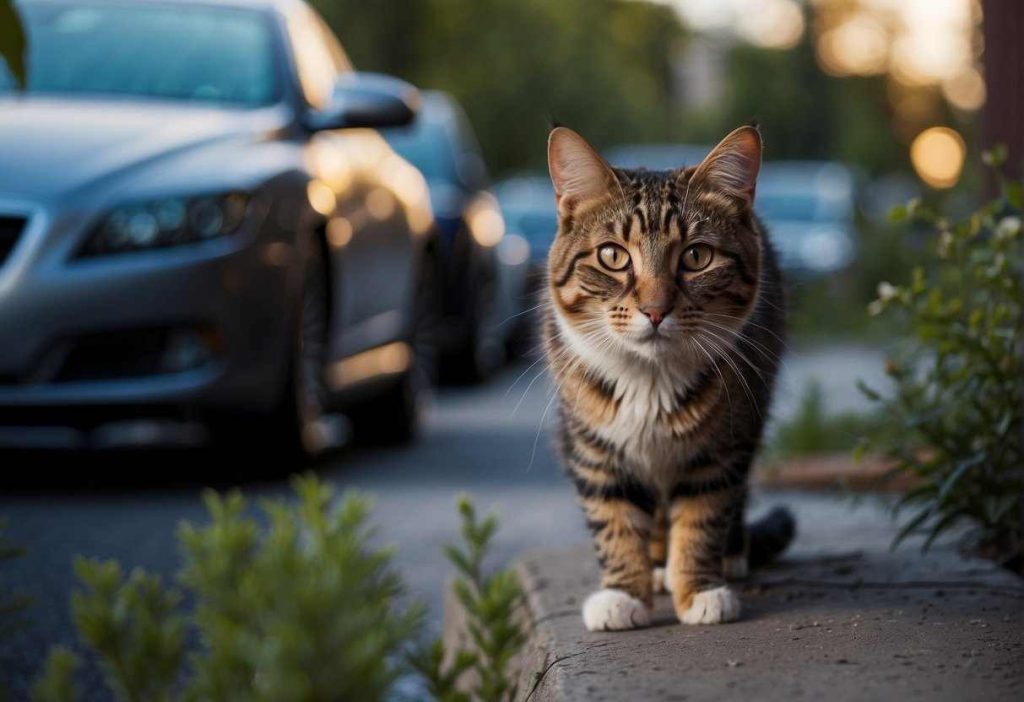
Natural Predators and Human Impact
Natural predators like coyotes and birds of prey, as well as their diet of rodents, often view feral cats as prey, making survival a real game of cat and mouse.
However, it’s not just nature they have to dodge; unfortunately, they also face risks from humans, who often view them as pests.
Nasty situations including traffic accidents or encounters with less-than-friendly individuals place these furry fellows in constant danger from predation, threatening bird populations and other wildlife.
Additionally, the presence of feral cats can also have a negative impact on bird populations, as they may hunt and kill birds as a food source. (6)
It is important to find a balance between protecting feral cats and preserving bird populations in order to maintain a healthy ecosystem.
Disease and Malnutrition
Did you know that feral cats are often on the losing end of the health battle? Diseases spread like wildfire among them, from pesky parasites like fleas to more severe ailments like feline leukemia and rabies.
Regular vet visits aren’t on their agenda, after all. And let’s talk about their dining situation—it’s not always a fish feast.
Malnutrition can be a common issue, making their already tough lives a bit more challenging, especially for adult cats who may have to resort to eating undercooked meat.
To make matters more complex, they can also have kittens at a rapid rate, with an unspayed pair potentially leading to hundreds of thousands of kittens in just seven years!
This is why it’s important to address the issue of feral cats and their potential impact on our pets’ health, as they can transmit parasites like fleas.
Are you curious about how these issues are managed? Some human heroes step in to lend a hand with programs like Trap-Neuter-and-Return (TNR), which helps to curb the population surge and gives these cats a fighting chance at a healthier life.
Remember, these cats’ lives are no walk in the park. But with a mix of awareness and action, we can make a difference in their daily struggles.
Keep these furry neighbors in mind next time you spot one on their journey through the urban jungle.
Quick Recap
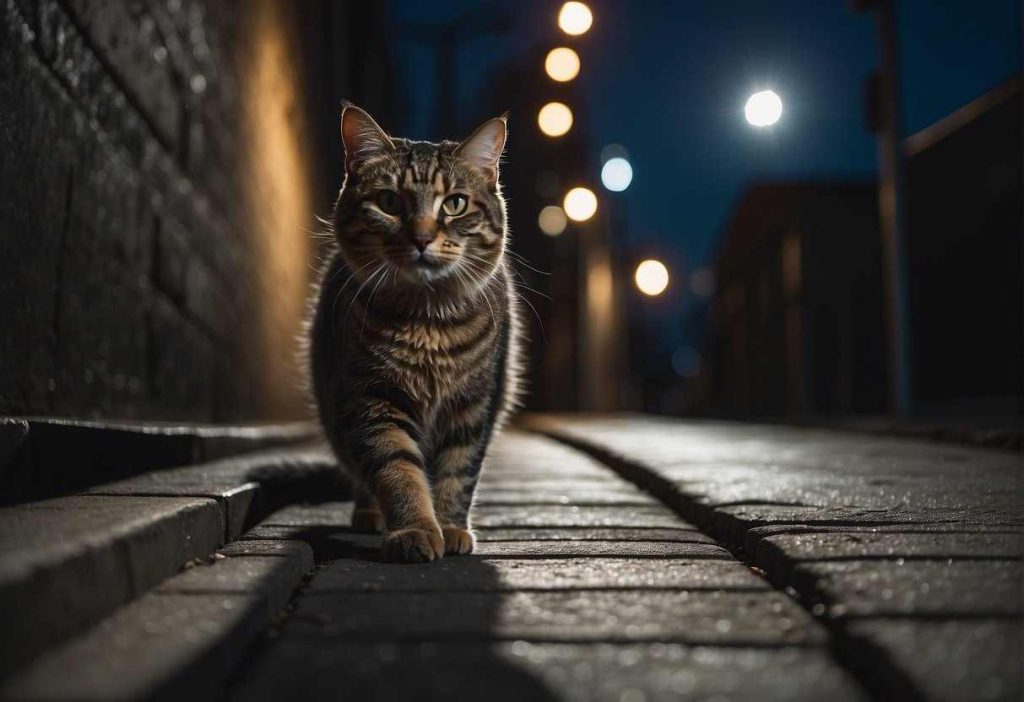
Feral cats, unlike their domesticated counterparts, face a whole different set of challenges.
Average Lifespan:
- 2-5 years: This is the central bracket for their expected lifespan, although it’s on the lower end compared to pampered house cats.
Why so short? They are up against some serious hardships such as:
- Predators: Imagine having to look over your shoulder constantly for the neighborhood coyote.
- Diseases: Without vaccinations, these guys are more susceptible to illnesses. (7)
- Human Threats: Unfortunately, not all humans are cat fans.
What about reproduction? Two unsterilized feral cats could potentially lead to a whopping 420,000 kittens over seven years! Talk about a feline takeover.
And communication? Here’s a quirky fact: feral cats are less likely to meow.
They communicate through other cat noises but they reserve that plaintive meow mainly for us humans—quite the selective speakers, aren’t they?
So, you see, while a feral cat’s life may be shorter, it’s incredibly impactful on their environment. Next time you cross paths with one, you’ll understand a bit more about the tough life they lead.
Remember, while this summary offers a glimpse into the life of feral cats, their future hinges on our understanding and support.
Now that you’re in the know, you might view these independent felines through a lens of admiration for their resilience.
Frequently Asked Questions
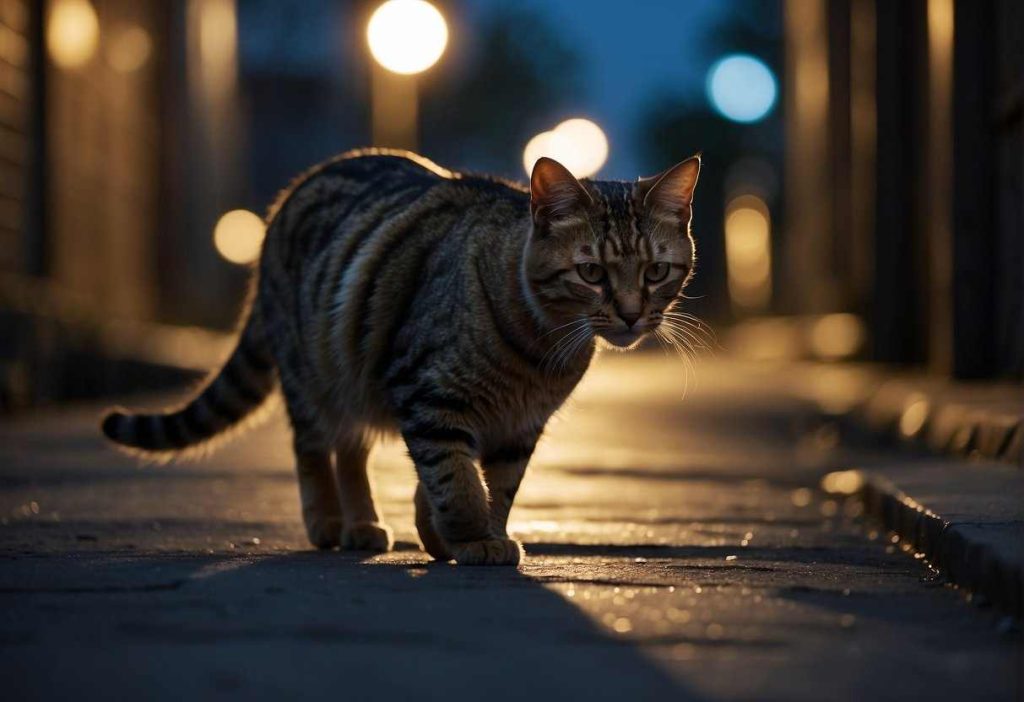
Curious about feral cats and how they fare in the wild? Let’s dive into some of the most common questions you might have about these resourceful and resilient creatures.
What is the average lifespan of a feral cat?
The average lifespan of a feral cat is considerably shorter than a cozy house cat’s, often ranging between 2 to 5 years. Yes, it’s quite a tough life out there!
How do Trap-Neuter-Return (TNR) programs affect the lifespan of feral cats?
While the specifics can vary, such interventions have been shown to improve their quality of life, reduce overpopulation, and potentially extend their lifespans.
What diseases commonly affect feral cats and how do they impact their lifespan?
You might not know this, but feral cats are often exposed to diseases like FIV, FeLV, and other infections that can significantly shorten their lives.
It’s a rough world out there without vaccinations and vet care.
Do feral cats tend to hide when it’s their time to pass away?
It’s a bit sad to think about, but yes, feral cats, like many animals, often seek solitude and shelter when they sense their time is coming.
It’s their final act of independence, you could say.
Can feeding feral cats extend their lifespan?
Providing food can indeed help feral cats live longer by reducing the energy they must expend to find food, but remember, it’s part of a bigger picture that includes shelter and healthcare.
What are the main factors that result in a shorter lifespan for feral cats?
Life’s not a cakewalk for feral cats. The main culprits cutting their lives short include disease, lack of shelter, predator threats, and the harsh reality of surviving without consistent food sources.
What are the main threats to the survival of feral cats?
Besides the struggle for food and shelter, they also confront dangers from traffic, humans, other animals, and environmental extremes.
It’s a full-on survival mode for these felines.
- Where to find the most trustworthy real money casinos - August 7, 2025
- Online Casinos That Approve PayPal: The Ultimate Overview - August 7, 2025

